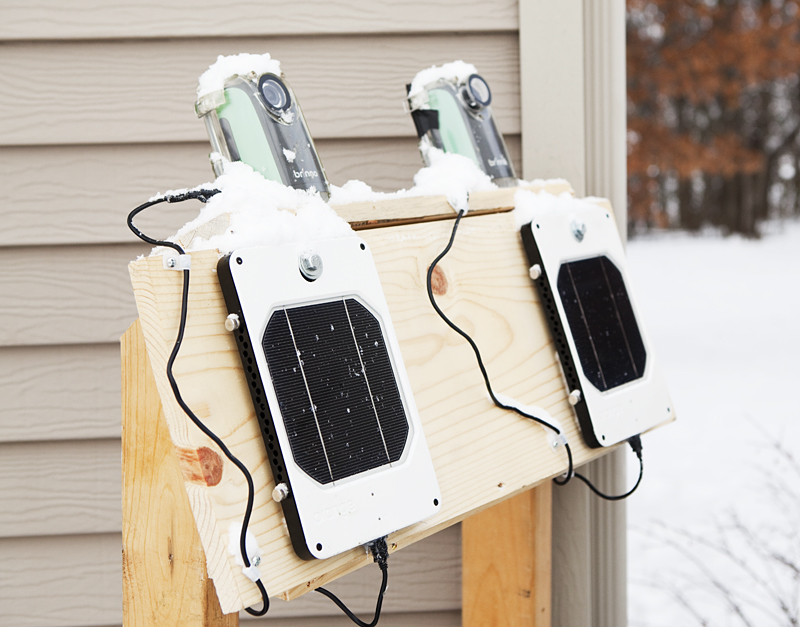2019 UPDATE: If you want an amazing new long term time lapse camera, please check out the Afidus ATL-200 at www.AfidusCam.com. We also have a web site dedicated to sales and support of time lapse cameras at www.TimeLapseCameras.com. Customer care is very important to us and we are here to ensure your time lapse project is a success.
Update: Solar Joos panels, are no longer available. If you are looking for long term time lapse information, please reach out to us at www.TimeLapseCameras.com.
I have had two Solar Joos Orange panels for about three months and have tested them extensively in many situations as a power source for the Brinno time lapse cameras.
In a previous post, Introducing a Solar Panel for your Brinno Time Lapse Camera, I gave my initial impressions, did a freezer test, overcast day test and an extended length darkness test. At the time, I was very impressed and now, after additional testing, I am very confident the Solar Joos panel will power your Brinno camera for months, even years without an issue.
Before I get into my testing, let me stray off track for a minute. The Solar Joos is a great product, weatherproof, sturdy and would survive the most extreme conditions. Here are some other scenarios I can think of where the Joos would be a perfect fit to keep your phone, GPS, GoPro, camera, portable game system and other devices charged.
Any back-country camping, hiking, skiing, snowmobiling or extreme adventure.
Emergency power in your vehicle in case of being stranded or a remote area accident.
Emergency power in your home to maintain communications due to a power outage or natural disaster.
Extended boating, river rafting, horseback ride trips.
A power source at a remote cabin, ice fishing shack, etc.
I started my latest tests in October and wanted to see how the Joos would perform in cold Minnesota weather. I built a test stand for both panels and at first kept the cameras indoors. I wanted to check the cameras often too see if power was lost. This test was done without batteries and even though my panels were at a bad angle (they collected snow) the panels powered the cameras for a couple weeks and were still at 100% charge when I reconfigured them at a different angle and wanted the cameras outside too.
Here is a photo from my latest test which has been ongoing for over two months. I made the mount angle steeper and removed the reflectors. The steeper angle was to keep snow from collecting on the panel. I removed the reflectors to see if they are necessary and in my opinion they are not, for powering Brinno cameras.
For this test I installed Energizer Ultimate Lithium batteries in the cameras. I have been told by Brinno techs, when the camera is connected to DC power, the batteries act as a back-up and only used if DC power is lost. I have used lithium batteries in the past with excellent results. I figure, there is little chance of the Solar Joos not providing power, but if it does the lithium batteries are a worry free backup.
For long term projects, in my case primarily construction, the Brinno battery life is amazing. I have often left cameras for three or four months unattended, which is well beyond Brinno's recommendations. I find myself falling behind when it comes to checking on cameras. Having a Solar Joos as a secondary power source would be a great peace of mind. As always, my primary concern with a long term project, is not the camera's battery life, rather an unplanned natural occurrence which interrupts the recording. A bird doing it's business on the lens, lightning, high winds, etc., all unlikely but possible.
The Solar Joos is the only product I recommend as a secondary source of power for your Brinno camera. It is my understanding there will soon be a bundled Joos and camera combination from BrinnoUSA.
For now, I only recommend the Joos for use with the Brinno TLC 200 f1.2 or the Brinno Construction Camera. The Joos will work with the Brinno TLC 200 Pro, however, if power is lost and then returns the camera shuts off. With the Construction Cam, if power is lost the batteries take over and when power is restored the camera keeps running. There is a firmware fix in the works, for the Pro to allow full functionality of the Joos.
Below is a short video showing the duration of sunlight hitting my test panels above which is direct sun for only about three hours.
The Brinno cameras are great products, the Solar Joos is a great product. Together they have an unprecedented ability to capture long term projects without user intervention. This concludes my testing of the Joos, my next post will detail mounting, connecting and weather proofing the cable connections.









